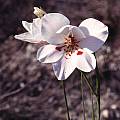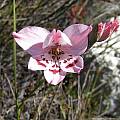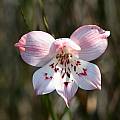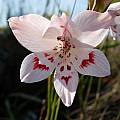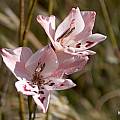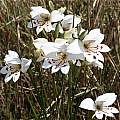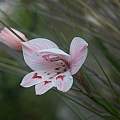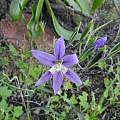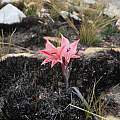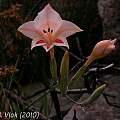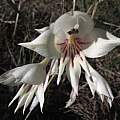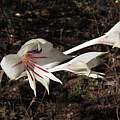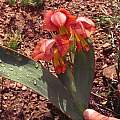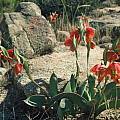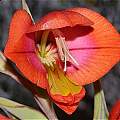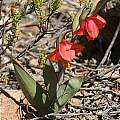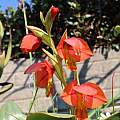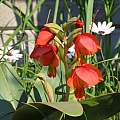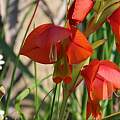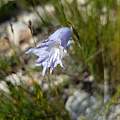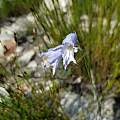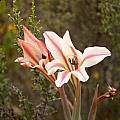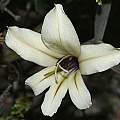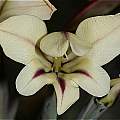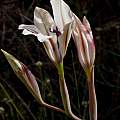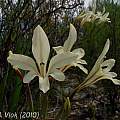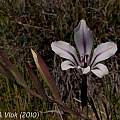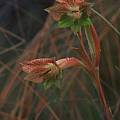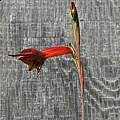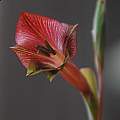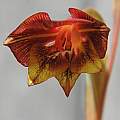Winter rain Gladiolus like their winters wet and mild and may need a dry summer dormancy. They are often less hardy, reaching down to USDA zone 8 at most.
Page 1: G. abbreviatus... Page 2: G. bonaspei... Page 3: G. carmineus... Page 5: G. gracilis... Page 6: G. inflatus... Page 7: G. maculatus... Page 8: G. mutabilis... Page 9: G. pulcherrimus... Page 10: G. saccatus... Page 11: G. teretifolius...
Gladiolus debilis Ker Gawler is found on rocky sandstone slopes in the southwest Cape, blooming in spring with white to pale pink flowers with red markings on the lower tepals. The first photo by Mary Sue Ittner was taken in September 2001 in an area in the southwest Cape that had burned the year previously and the second was taken by Bob Rutemoeller September 2003 at Boskloof. The third was taken by Ragnhild Crawford. Photos four and five taken near Napier in the Overberg by Cameron McMaster. The sixth photo was taken by Andrew Harvie at Silvermine in Table Mountain National Park. Last photo by Christopher Whitehouse, taken at the Phillpskop Mountain Reserve near Stanford.
Gladiolus deserticola Goldblatt is restricted to the Richtersveld, a mountainous area of northern Namaqualand. Plants grow in sheltered sites, most frequently in clay soils on south-facing slopes protected by rock or shrubs. Flowers are dark blue with a darker line in the midline of the tepals. The lower tepals or the lateral lower tepals are cream edged with purple. Flowers are weakly rose scented. Photo from Rachel Saunders who found a single specimen blooming in July 2011, a bit early for this species that usually blooms mid August to mid September.
Gladiolus dolichosiphon Goldblatt & J.C-Manning was first described in 2009, after a first collection from 1986 wasn't correctly identified as new species. It grows on seasonally wet places on cool south-facing slopes in altitudes above 1300 m in the western little Karoo. The flower spike holding 4 to 7 seven pink to creamy salmon unscented flowers with the lower three tepals each with a pale lozenge-shaped median mark outlined in dark red may have up to two lateral branches. It is a member of the long tubed pink flowered Gladiolus carneus complex but is distinguished from that group by its 5 or 6 linear leaves, creamy pink to salmon flowers with a tube 30-50 mm long and longer than the dorsal tepal, and its late summer flowering (late January to mid February). The first photo from Rachel Saunders was taken the second year after a fire, January 2017. The second photo from the book Plants of the Klein Karoo courtesy of Jan and Anne Lise Schutte-Vlok.
Gladiolus engysiphon G.J.Lewis is found in clay and granitic loam in renosterveld and grassland in the Langeberg Center (Swellendam to Mossel Bay). Growing from 35 to 50 cm high, it flowers March to April. The cream flowers with red median streaks are arranged in a 2 to 6 flowered spike. Photos taken by Rogan Roth in the southern Cape in April 2021. He first thought it was Gladiolus bilineatus which has a similar flower, distribution, and flowering time in the autumn. Both are pollinated by a species of long-proboscid fly. According to John Manning the lowest leaf in Gladiolus bilineatus always develops a short, sword-shaped blade, whereas the leaf blades in Gladiolus engysiphon are either absent entirely or needle-like. The arrangement of the leaves and the diameter of the stem is also different in the two species.
Gladiolus equitans Thunberg is very similar to Gladiolus alatus but has short, broad leathery leaves with raised margins and grows on rocky hills in Namaqualand. The first one was photographed in Namaqualand in August 2001 just after it rained by Mary Sue Ittner. The second photo was taken in about the same place in September 2006 by Bob Rutemoeller, but the plants were already in seed this time. The third picture was taken by Rod Saunders. The fourth and fifth photos were taken in habitat in the Kamiesberg by Andrew Harvie.
Photos below were taken by Alan Horstmann.
Gladiolus exilis G.J.Lewis is a fall-blooming, winter-growing species from the mountains of the Western Cape where it grows in clay loam in fynbos. Growing from 25-45 cm tall, it has white to pale blue fragrant flowers with dark streaks on the lower tepals. It looks similar to Gladiolus gracilis. Photos from iNaturalist taken by Peter Thompson in the Western Cape in May and shared under a CC BY-NC license.
Gladiolus floribundus Jacq. grows on dry clay, sandy or limestone flats and slopes over a broad area of the winter rainfall Cape. It has white to cream or pinkish flowers with a dark median streak on all of the tepals and blooms in late spring. The first two photos taken by Cameron McMaster near Napier in the Overberg. Photos three, four, and five were taken by Andrew Harvie. Photo three was also taken in the Overberg in the De Hoop Nature Reserve. The last two were taken on a a rocky ridge top in the Swartberg Mountains.
Photos below from the book Plants of the Klein Karoo courtesy of Jan and Anne Lise Schutte-Vlok who write that this species grows up to 60 cm tall with broad grey green leaves. It can be confused with Gladiolus grandiflorus which has a shorter tube.
Gladiolus fourcadei (L.Bolus) Goldblatt & M.P.de Vos, syn. Homoglossum fourcadei (L.Bolus) N.E.Br, syn. Antholyza fourcadei L.Bolus, grows in a variety of soils in the Uniondale district of the Southern Cape. It has small, greenish yellow flowers with reddish veins and spots. This species is endangered, and reportedly now grows in only a single location threatened by overgrazing. The first photo was taken by Rod Saunders and the next three by Mary Sue Ittner.
Page 1: G. abbreviatus... Page 2: G. bonaspei... Page 3: G. carmineus... Page 5: G. gracilis... Page 6: G. inflatus... Page 7: G. maculatus... Page 8: G. mutabilis... Page 9: G. pulcherrimus... Page 10: G. saccatus... Page 11: G. teretifolius...
